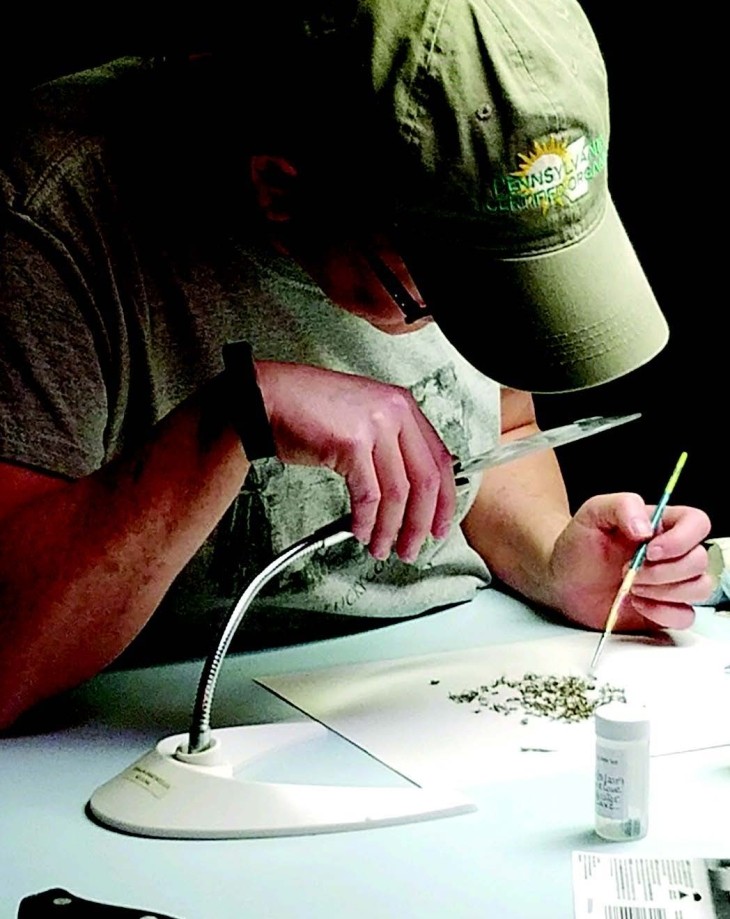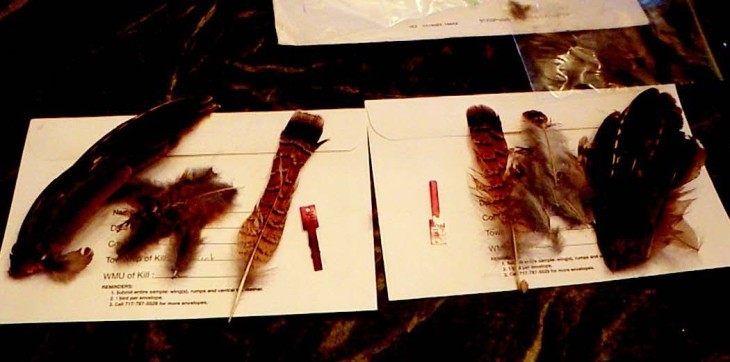
For six weeks every October and November, Sean Flint spends two or three days a week walking through thick underbrush in Vermont and flushing ruffed grouse with his dog, Finn. Last year, Flint (who is also a biologist with the U.S. Fish & Wildlife Service) had something relatively new in the pocket of his hunting vest: a kit to collect blood and feather samples from ruffed grouse. The samples are part of a multistate effort to determine what effect the mosquito-borne West Nile virus is having on the grouse population.
According to a report by the Eastern Grouse Working Group, ruffed grouse populations have declined by 50 percent or more throughout the eastern United States in the last 30 years. Across the ruffed grouse’s range, habitat loss – particularly the loss of young forests with dense, shrubby trees that provide food and protection for the birds – drives population declines. In the report, wildlife biologists also point to shifts in climate, predator regimes, and changing land use as contributing factors to the decreasing grouse population. Recently, that list of woes has grown to include West Nile virus.
Flint received the test kit from Chris Bernier, the upland game bird team leader for the Vermont Department of Fish & Wildlife. While ruffed grouse numbers remain robust in Vermont, Bernier said, there is evidence of a decline. Collecting the blood for the regional study is part of a broader effort to compile more data on Vermont’s ruffed grouse, Bernier explained.
Often, hunters are key partners in gathering information from the field. Bernier said he had only 100 testing kits to share and was so overwhelmed by interest from hunters that he could have used 500 kits. That interest extends to Pennsylvania, according to Lisa Williams, wildlife biologist with the Pennsylvania Game Commission. When Williams realized she was seeing drops in the state’s reported grouse numbers that couldn’t be explained by either natural population cycles or habitat loss, she turned to Pennsylvania’s hunter-cooperators, who keep detailed diaries of their hunts for the state.
“In the last 20 years, grouse abundance indices have declined by an average of 84 percent in the Mid-Atlantic region, 71 percent in the Southeast region, and 69 percent in the New England region,” Williams said.

But in 2013, Williams noticed that “the habitat [was] not collapsing as fast as these birds [were] collapsing.” There had to be another factor. “It was such a puzzle,” she said. “A really depressing one.”
West Nile virus proved to be a key piece of the puzzle. Introduced to the United States in 1999, West Nile virus is transmitted by mosquitoes and in rare cases can be fatal in humans. According to the Centers for Disease Control (CDC), the virus has been found in more than 300 species of birds, which also can die from it. Observant hunters in Pennsylvania noticed that ruffed grouse numbers started to decline in the early 2000s. Laboratory tests and population data collected over decades showed that the excess ruffed grouse deaths in Pennsylvania were likely from West Nile virus.
Vermont is one of 12 states in the region participating in the collection of ruffed grouse blood samples for West Nile virus testing, also known as a sero-survey. The other participating states include Maine, New Hampshire, Massachusetts, and New York. While Bernier doesn’t think West Nile virus is having a big impact on Vermont’s ruffed grouse population, he said the Vermont sero-survey still has an important role to play. The scientists collecting data from the survey hope to find out how climate, elevation, habitat, and other factors influence the birds’ risk from West Nile virus. The hope is that, on a local scale, areas where the grouse are at low risk for the virus can be prioritized for habitat restoration efforts.
In Vermont, the findings from the sero-survey have tracked strongly with the state’s mosquito monitoring for West Nile virus. In the first year of the study, the percentage of ruffed grouse testing positive for exposure to West Nile virus was 16.7 percent, Bernier said. In the second year, the percentage dropped to 2.6 percent, and the prevalence of West Nile virus in mosquitoes trapped by the Vermont Department of Health showed a similar drop.
“Whatever is driving the prevalence of West Nile virus in mosquitoes is going to control the prevalence of West Nile virus in grouse. That could be climate, but also habitat,” Bernier added.
The study’s most important result may not be a specific scientific finding, but the creation of ongoing collaboration. Last year, 30 biologists representing more than 20 states came together to form the Eastern Grouse Working Group. The organization has already written a paper on the region’s grouse decline; more significantly, said Bernier and Williams, they are in a position to work together on region-wide solutions.




Discussion *